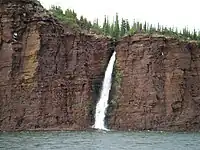| Coppermine River | |
|---|---|
 View of the Arctic Sea from the mouth of the Coppermine River (1821) by George Back | |
 Coppermine River mouth location | |
| Location | |
| Country | Canada |
| Physical characteristics | |
| Source | Lac de Gras |
| • location | Northwest Territories, Canada |
| • coordinates | 64°35′01″N 111°11′33″W / 64.58361°N 111.19250°W |
| • elevation | 396 m (1,299 ft) |
| Mouth | Coronation Gulf |
• location | Nunavut, Arctic Ocean, Canada |
• coordinates | 67°48′43″N 115°05′05″W / 67.81194°N 115.08472°W |
• elevation | 0 m (0 ft) |
| Length | 845 km (525 mi) |
| Basin size | 50,700 km2 (19,600 sq mi) |
| Discharge | |
| • average | 337.69 m3/s (11,925 cu ft/s)[1] |
| • minimum | 10.37 m3/s (366 cu ft/s) |
| • maximum | 1,500 m3/s (53,000 cu ft/s) |
| [2][3] | |
The Coppermine River is a river in the North Slave and Kitikmeot regions of the Northwest Territories and Nunavut in Canada. It is 845 kilometres (525 mi)[4] long. It rises in Lac de Gras, a small lake near Great Slave Lake, and flows generally north to Coronation Gulf, an arm of the Arctic Ocean. The river freezes in winter but may still flow under the ice.
The community of Kugluktuk (formerly Coppermine) is located at the river's mouth.
The river was named for the copper ores which are located along the river, by Samuel Hearne in 1771.[5] Hearne found only one lump of copper and commercial mining was not considered viable.[6]
Bloody Falls, part of the Kugluk/Bloody Falls Territorial Park, is located 18.5 kilometres (11.5 mi) from Kugluktuk, and was home to the Kogluktogmiut a sub-group of the Copper Inuit. It is the site of the Bloody Falls Massacre, when Matonabbee, Samuel Hearne's guide, and his fellow Chipewyan warriors ambushed and massacred the local Inuit.[7]
Gallery
 Canoeists camping along river |
 One of many waterfalls along the river |
 Canoeing the Rocky Defile |
 Bloody Falls |
See also
References
- ↑ "Coppermine River above Bloody Falls". R-ARCTICNET. Retrieved 2017-08-11.
- ↑ "Natural Resources Canada-Canadian Geographical Names (Coppermine River)". Retrieved 2014-08-29.
- ↑ "Atlas of Canada Toporama". Retrieved 2014-08-29.
- ↑ Coppermine river at the Archived 2008-10-14 at the Wayback Machine Atlas of Canada
- ↑ "Coppermine River". Encyclopaedia Britannica. Retrieved 10 November 2019.
- ↑ Douglas, George Mellis (1914). Lands Forlorn: A Story of an Expedition to Hearne's Coppermine River. p. 3. Retrieved March 10, 2020.
- ↑ Hearne, Samuel (1795), A journey from Prince of Wales's Fort, in Hudson's Bay, to the northern ocean ... in the years 1769, 1770, 1771 & 1772, London: Strahan & Cadell, archived from the original on June 12, 2011, retrieved March 10, 2020
Further reading
- Dredge, L. A. Where the river meets the sea geology and landforms of the lower Coppermine River Valley and Kugluktuk, Nunavut. [Ottawa]: Geological Survey of Canada, 2001. ISBN 0-660-18550-4
- Steele, Peter. The Man Who Mapped The Arctic: The Intrepid Life of George Back, Franklin's Lieutenant, 2003. ISBN 978-1551926483
External links
- Coppermine Heritage River - Nunavut Parks at the Wayback Machine (archived June 18, 2009)
- Coppermine Heritage River at archive.today (archived September 30, 2007)
- . The American Cyclopædia. 1879.